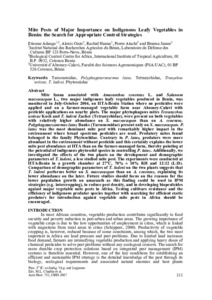| dc.contributor.author | Adango, E. |
| dc.contributor.author | Onzo, A. |
| dc.contributor.author | Hanna, R. |
| dc.contributor.author | Atachi, P. |
| dc.contributor.author | James, B. |
| dc.date.accessioned | 2019-12-04T11:19:42Z |
| dc.date.available | 2019-12-04T11:19:42Z |
| dc.date.issued | 2007 |
| dc.identifier.citation | Adango, E., Onzo, A., Hanna, R., Atachi, P. & James, B. (2007). Mite pests of major importance on indigenous leafy vegetables in Benin: the search for appropriate control strategies. Acta Horticulturae, 752, 311-318. |
| dc.identifier.uri | https://hdl.handle.net/20.500.12478/3512 |
| dc.description.abstract | Mite fauna associated with Amaranthus cruentus L. and Solanum macrocarpon L., two major indigenous leafy vegetables produced in Benin, was monitored in July-October 2004, on IITA-Benin Station where no pesticides were applied and on a farmer-managed vegetable farm near Abomey-Calavi with pesticide applications on nearby plots. The major phytophagous mites Tetranychus urticae Koch and T. ludeni Zacher (Tetranychidae), were present on both vegetables with relatively higher abundance on S. macrocarpon than on A. cruentus. Polyphagotarsonemus latus Banks (Tarsonemidae) present only on S. macrocarpon. P. latus was the most dominant mite pest with remarkably higher impact in the environment where broad spectrum pesticides are used. Predatory mites found belonged to the family Phytoseiidae. Contrary to P. latus, predators were more abundant in the environment without pesticide and this certainly explains the lower mite pest abundance at IITA than on the farmer-managed farm, thereby pointing at the potential of indigenous phytoseiid species in controlling P. latus. Additionally, we investigated the effects of the two plants on the development and demographic parameters of T. ludeni, a less studied mite pest. The experiments were conducted at IITA-Benin in a growth chamber at 27°C, 70% ± 10% RH and 12:12 (L:D). Comparison of demographic parameters of T. ludeni on the two plants suggests that T. ludeni performs better on S. macrocarpon than on A. cruentus, explaining its lower abundance on the later. Future studies should focus on the reasons for the lower population growth on amaranth as this finding could be used in IPM strategies (e.g. intercropping), to reduce pest density, and in developing biopesticides against major vegetable mite pests in Africa. Testing cultivars resistance and the efficiency of indigenous predator species together with searching for efficient exotic predators for introduction against vegetable mite pests in Africa should be encouraged. |
| dc.description.sponsorship | Swiss Agency for Development and Cooperation |
| dc.language.iso | en |
| dc.subject | Tarsonemidae |
| dc.subject | Polyphagotarsonemus Latus |
| dc.subject | Tetranychidae |
| dc.subject | Tranychus Urticae |
| dc.subject | T. Ludeni |
| dc.subject | Phytoseiidae |
| dc.subject | Pesticide |
| dc.subject | Predators |
| dc.title | Mite pests of major importance on indigenous leafy vegetables in Benin: the search for appropriate control strategies |
| dc.type | Journal Article |
| dc.description.version | Peer Review |
| cg.contributor.affiliation | Institut National des Recherches Agricoles du Bénin |
| cg.contributor.affiliation | International Institute of Tropical Agriculture |
| cg.contributor.affiliation | Université d'Abomey Calavi |
| cg.coverage.region | Africa |
| cg.coverage.region | West Africa |
| cg.coverage.country | Benin |
| cg.authorship.types | CGIAR and developing country institute |
| cg.iitasubject | Pests Of Plants |
| cg.iitasubject | Disease Control |
| cg.iitasubject | Handling, Transport, Storage And Protection Of Agricultural Products |
| cg.iitasubject | Farm Management |
| cg.iitasubject | Impact Assessment |
| cg.iitasubject | Capacity Development |
| cg.iitasubject | Plant Breeding |
| cg.iitasubject | Plant Diseases |
| cg.iitasubject | Farming Systems |
| cg.iitasubject | Plant Production |
| cg.accessibilitystatus | Limited Access |
| local.dspaceid | 95483 |
| cg.identifier.doi | https://doi.org/10.17660/ActaHortic.2007.752.53 |

